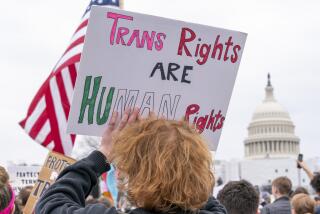Supreme Court will look at whether a cross is promotion of religion or war memorial
- Share via
Reporting from Washington — The Supreme Court justices, long divided on the role of religion, are set to decide whether a 40-foot Latin cross sitting at a busy intersection in Maryland is an unconstitutional official endorsement of Christianity or a historic memorial for local soldiers who died in World War I.
It will be the first major religion case for Justice Brett M. Kavanaugh, and the outcome could signal whether the court’s five conservatives are prepared to give small towns, counties and states more freedom to display Christian symbols.
At issue is the 1st Amendment’s ban against “an establishment of religion.” The justices agree this means the government must be neutral toward religion and may not favor one faith. “The clearest command of the Establishment Clause is that one religious denomination cannot be officially preferred over another,” Chief Justice John G. Roberts Jr. wrote last year, quoting a 1982 opinion.
But the justices have disagreed on how to apply this no-preference rule, with conservative Catholic justices often pitted against the liberal Jewish justices.
In 2014, the court in a 5-4 decision upheld a city council’s practice of beginning its monthly meetings with a Christian prayer delivered by a local cleric. The five justices in the majority, all Catholics, said this “comports with our tradition and does not coerce participation by non-adherents.”
In dissent, Justice Elena Kagan, joined by the two other Jewish justices, said Jews and Muslims should not be treated as outsiders at their town’s meetings.
Last year, the high court ruled for a Christian baker of wedding cakes on the grounds he was subjected to “hostility” because of his faith. A Colorado civil rights commission had held the baker violated the state’s anti-discrimination law by refusing to make a cake for a same-sex couple. In overturning that decision, Justice Anthony M. Kennedy pointed to one of seven commission members who had commented that “religion has been used to justify all kinds of discrimination throughout history.”
But three weeks later, the court by a 5-4 vote rejected the claim that President Trump’s travel ban reflected “hostility” toward Muslims.
This divide flared up earlier this month in a late-night order involving an Alabama execution. The court’s five conservatives overturned a lower court and cleared the way for the state to execute a Muslim prisoner. He had asked to have his imam present in the execution chamber, but the state refused. However, it regularly allows a Christian chaplain to be present during executions because he is a state employee. In a dissent for the four liberals, Kagan called the decision “profoundly wrong” because it reflects “religious discrimination.”
The justices are likely to be divided on Wednesday when they hear arguments on the fate of the so-called Peace Cross in Bladensburg, Md., a monument built with private funds in the early 1920s to honor 49 soldiers who were killed in Europe. Since 1961, however, it has been maintained on public property by the park commission for Maryland and the National Capital area.
About five years ago, three local residents said they objected to seeing the cross towering over the intersection when they drove by, and they joined a lawsuit with the American Humanist Assn. They said they did not want the monument to be torn down, but instead moved to private property. They lost before a federal judge, but won a 2-1 ruling from the 4th Circuit Court of Appeals.
“The monument here has the primary effect of endorsing religion and excessively entangles the government in religion,” wrote Judge Stephanie Thacker. “The Latin cross is the core symbol of Christianity. … Therefore, we hold that the purported war memorial breaches the ‘wall of separation between Church and State,’” she said, quoting words of Thomas Jefferson that were adopted by the court in 1947.
In November, three weeks after Kavanaugh took his seat, the Supreme Court agreed to hear appeals from from the American Legion, which had defended the memorial, and from the regional parks commission. The case is American Legion vs. American Humanist Assn.
In past decades, the justices have been closely split when faced with disputes over religious symbols on public property. In the 1980s, for example, they upheld a city’s display of a Nativity scene during the Christmas season when it also included Santa Claus, reindeer and a colorful tree, but not if it stood alone in a government building. Both rulings were by 5-4 votes.
In 2005, they handed down two contrary decisions on the Ten Commandments on the same day. They upheld a granite monument containing the commandments that had stood for decades on the grounds of the Texas state Capitol, but struck down a prominent new display of commandments inside a county courthouse in Kentucky. Both were 5-4 decisions, with Justice Stephen G. Breyer casting the key votes.
Most legal experts predict the justices will rule in favor of maintaining the cross. They are watching closely, however, to see whether they will do so on narrow grounds or more broadly.
For example, the court could rule narrowly that the Peace Cross can remain because it has stood for nearly a century and because it was erected as a war memorial. Advocates of this approach cited Breyer’s 2005 opinion in the two cases involving the Ten Commandments. He said officials would violate the 1st Amendment if they put up new religious displays, but this does not require ripping up old granite monuments or tearing down faded murals in courthouses. High above the Supreme Court’s courtroom are marble friezes of great lawmakers of ancient history, including a depiction of Moses holding a tablet with the commandments.
“The Establishment Clause does not compel the government to purge from the public sphere all that in any way partakes of the religious,” Breyer wrote in Van Orden vs. Perry.
It is also possible that the chief justice will seek to have the lawsuit thrown out the grounds the three plaintiffs lack standing. In the past, several justices have questioned how a plaintiff is injured or harmed by the presence of religious symbol on public property.
But lawyers for the American Legion urge the court to rule broadly. They say “passive displays” of the cross or any religious symbol should be upheld because no one is forced to participate in a religious exercise. In the past, Justice Clarence Thomas and the late Justice Antonin Scalia espoused this so-called “no coercion” rule.
Defenders of church-state separation say this would amount to a major change.
“I am very concerned the court might adopt the view that the Establishment Clause is violated only if there is coercion. There well might be five votes for this approach,” said Erwin Chemerinsky, dean of the UC Berkeley Law School. If so, “there would be no limit on religious symbols on government property. A city could put a large cross atop city hall or in front of its chambers and it would be allowed because there is not coercion.”
Holly Hollman, general counsel for the Baptist Joint Committee on Religious Liberty, joined with the American Jewish Congress and other faith groups in urging the court to hold the line on church-state separation. “The cross is the singular symbol of Christianity,” she said. “I hope the court will say that government cannot pick and choose between religions or promote a religious message.”
More stories from David G. Savage »
More to Read
Get the L.A. Times Politics newsletter
Deeply reported insights into legislation, politics and policy from Sacramento, Washington and beyond. In your inbox three times per week.
You may occasionally receive promotional content from the Los Angeles Times.











